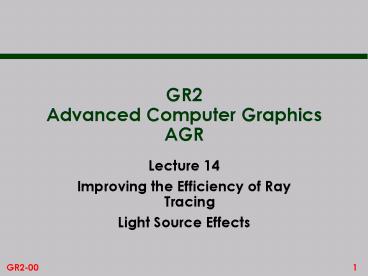GR2 Advanced Computer Graphics AGR - PowerPoint PPT Presentation
1 / 27
Title:
GR2 Advanced Computer Graphics AGR
Description:
Spotlight. Spotlight in same. position as. previous. point light. Cone angle ... Spotlight - Soft Shadows. Softer shadow. obtained by having. a gradual drop-off ... – PowerPoint PPT presentation
Number of Views:57
Avg rating:3.0/5.0
Title: GR2 Advanced Computer Graphics AGR
1
GR2Advanced Computer GraphicsAGR
- Lecture 14
- Improving the Efficiency of Ray Tracing
- Light Source Effects
2
Advantages and Disadvantages of Ray Tracing
- Ray tracing is attractive because
- shadows, reflections, refractions are easily
incorporated - Ray tracing is expensive because
- the cost of computing ray-object intersections is
very high - This part of the lecture looks at efficiency
issues in ray tracing
3
Ray Tracing - A Reminder
The intensity calculation is now I I local k
r I reflected k t I transmitted
I reflected and I transmitted are calculated
recursively
4
Adaptive Tree Depth Control
- Basic algorithm follows rays until they leave the
scene (or hit diffuse surface) - in theory the
tree depth can then be considerable - In practice, it is not usually necessary to trace
rays to any great depth - As tree formed, a running product is kept of
transmission and reflection coefficients - this product attenuates all intensities lower in
tree - once product less than threshold, branch is
stopped
5
Bounding Volumes
- Enclose groups of objects in a simple bounding
volume - sphere or box
- Test for intersection against bounding volume
- if none, then ray does not intersect objects
within - if intersection occurs, test against each object
in turn - Idea can be extended to hierarchies of bounding
volumes (usually boxes)
6
Spatial Subdivision
- Idea divide space into subregions, noting
objects in each subregion - termed spatial subdivision or spatial
coherence - Calculation changes from
- for each object or bounding box, find ray
intersection - to
- as ray proceeds through space, are there any
objects in the current subregion? - if yes, calculate intersections if not, move on
- find next subregion entered by the ray
7
How do we Subdivide Space
- One idea is octree partitioning
- We illustrate in 2D - known as quadtree
First divide space into four regions Count
number of objects in each region If a region
contains an object, subdivide again Continue to
a specified level of subdivision
8
Octree
A tree structure emerges, with the nodes at the
leaves of the tree containing (hopefully) a small
number of objects, or empty.
This is quadtree - in 3D we subdivide cube into 8
each time, getting an octree
9
Ray Tracing through Octree
We trace ray from subregion to subregion, only
doing intersection tests for the small number of
objects in the subregion.
Find region corresponding to start point. Test
ray for intersections with any objects. If none,
find next region - by calculating intersection
with region boundaries. Advance a short way into
next region - say to (x,y,z) Find region which
includes (x,y,z) and continue.
10
Finding Region Containing (x,y,z)
We use octree itself to locate region. Starting
at top, a simple test determines in which of
eight (4 for quadtree) regions the point (x,y,z)
lies. Proceed down tree until leaf node reached.
11
Binary Space Partitioning
- An alternative to octrees is just to split into
two at each step - separating plane typically chosen to divide space
into regions of equal complexity - Known as Binary Space Partitioning, or BSP, trees
12
Octrees versus BSP trees
- Octrees
- good for scenes where density of objects varies
widely - possible to have small objects in large regions
- stepping from region to region slow because trees
tend to be unbalanced - BSP trees
- depth of tree smaller because tree balanced
- memory costs lower
- void areas smaller
13
Ray Tracing Software
- Persistence Of Vision Ray Tracer (POV-RAY) is
public domain ray tracing software - Download from
- http//www.povray.org
14
More Teapots! The POVRAY version
15
POVLAB modeller
16
- Lecture 14
- Part 2
- Light Source Effects
17
Light Source Sequence of Images
- The following sequence of images were created by
Alan Watt of University of Sheffield - They illustrate effects of different light
sources in a scene
18
Ambient Light Only
19
Camera Light Source
Light source at camera only. Note no shadows.
20
Distant Light Source
Light rays parallel to each other Note shadows
21
Point Light Source
Point light source close to object, in same
direction as distant source in previous
picture. Note shadows are different.
22
Spotlight
Spotlight in same position as previous point
light. Cone angle is 30 deg. Note cone
of influence of the light, and the hard shadow.
23
Spotlight - Soft Shadows
Softer shadow obtained by having a gradual
drop-off of intensity at edge of cone (here over
last 5 deg)
24
Effect of Distance - No Attenuation
Here there is no attenuation of light over
distance
25
Effect of Distance - Attenuation
Intensity is attenuated by 1/distance
26
Effect of Distance - Attenuation
Here the attenuation factor is 1/(distance)2
27
Fog
Intensity of fog increases linearly with
depth. How is this achieved?































